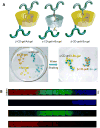Bottom-up tissue engineering
- PMID: 21524904
- PMCID: PMC3153565
- DOI: 10.1016/j.copbio.2011.04.001
Bottom-up tissue engineering
Abstract
Recapitulating the elegant structures formed during development is an extreme synthetic and biological challenge. Great progress has been made in developing materials to support transplanted cells, yet the complexity of tissues is far beyond that found in even the most advanced scaffolds. Self-assembly is a motif used in development and a route for the production of complex materials. Self-assembly of peptides, proteins and other molecules at the nanoscale is promising, but in addition, intriguing ideas are emerging for self-assembly of micron-scale structures. In this brief review, very recent advances in the assembly of micron-scale cell aggregates and microgels will be described and discussed.
Copyright © 2011 Elsevier Ltd. All rights reserved.
Figures




References
-
- Ott HC, Clippinger B, Conrad C, Schuetz C, Pomerantseva I, Ikonomou L, et al. Regeneration and orthotopic transplantation of a bioartificial lung. Nat Med. 2010;16:927–33. This paper along with reference 1 demonstrates the tremendous amount of information encoded in ECM. Additionally, the architecture of the tissue seems to be of utmost importance. The bottom-up approach to scaffold formation may eventually be able to assemble such complex structures, but much more research will be required. - PubMed
-
- Badylak SF, Freytes DO, Gilbert TW. Extracellular matrix as a biological scaffold material: Structure and function. Acta biomaterialia. 2009;5:1–13. - PubMed
-
- Feynman RP. There's plenty of room at the bottom. Eng and Sci. 1961;23:22–36.
Publication types
MeSH terms
Substances
Grants and funding
LinkOut - more resources
Full Text Sources
Other Literature Sources

